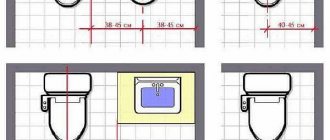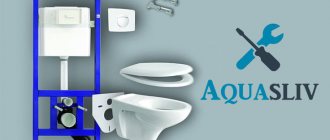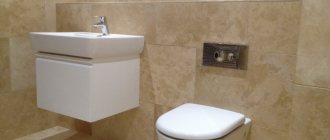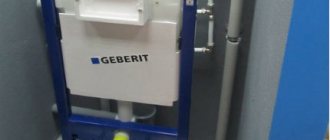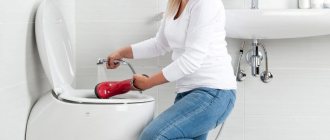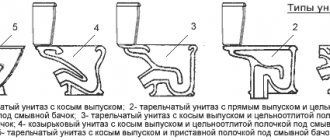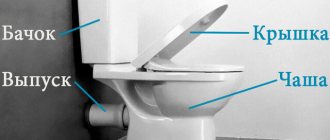The dimensions of the installation for a wall-hung toilet are the most important characteristic that determines how well the device will fit into the room.
Today, such toilets are confidently gaining popularity, since they radically transform the interior of the toilet and significantly facilitate its care.
Accordingly, the dimensions of these products are of interest to many potential buyers.
Wall-hung toilet design
To begin with, it’s worth briefly describing how this plumbing fixture works.
The idea is this:
- a steel frame is installed against the wall with a drain tank and pipeline fittings built into it - this is the installation;
- a partition (also called a false wall) made of plasterboard is erected in front of the frame, hiding both it itself and the pipes connected to it;
- The toilet is hung on studs, screwed into the frame in advance, and connected to the sewer pipe and flush cistern.
The advantages of this solution are obvious:
- The toilet looks very neat - only the walls and the toilet are visible. The tank and pipes are hidden, and therefore nothing disturbs the aesthetic harmony.
- The floor is completely free, so there are no difficult-to-clean areas.
- The murmur of water behind the partition and the soundproofing plate (supplied) becomes almost inaudible.
As you can see, there is nothing complicated in the design of a wall-hung toilet, but you need to keep in mind that installations can be very different and if the size of the toilet is limited, this must be taken into account.
A set of necessary tools
A block or frame installation is installed before finishing work in the bathroom. Installation work is not complicated and does not require extensive knowledge in the field of plumbing. To get started, you need to disassemble the existing instructions and study installation master classes. The tools needed for installation are usually found in every home.
For the installation process you must have:
- tape measure to take measurements.
- pencil or pen.
- building level.
- hammer drill with a set of drills for concrete.
- silicone sealant.
- FUM tape.
- open-end wrenches of different sizes.
Types of installation systems
There may be many minor differences, but the main thing is what the installation should be attached to. On this basis, such structures are divided into two types:
Block
Such structures are hung on a wall, which, of course, must be permanent. If you fix such an installation on a thin partition, it will immediately collapse under the user’s weight.
Block installation
Frame
Installations of this type are also called free-standing. They are not attached to the wall and transfer the entire load to the floor, so they have reinforced legs. Thus, such a structure can be installed even near a plasterboard partition.
Advantages and disadvantages
The undoubted advantages should be considered noiselessness, a tank hidden behind the wall, dual-mode drainage, high reliability of fastening, flexible adaptation in the interior.
There are not many disadvantages, but they do exist:
- the price of the wall-mounted model is higher than the regular one
- some installation specifics
- deliberately restricting access to transit communications (if it is an apartment building)
- the need for mandatory presence of capital load-bearing structures
- inaccessibility of the main components of the installed installation for inspection or maintenance
What is more important - the listed difficulties or unconditional comfort from use - is up to the future owner to decide.
Standard dimensions
The most significant parameter is the depth of the installation - it determines how comfortable it will be to use the toilet (there should be at least 60 cm of free space in front of it). The type of installation is decisive here:
- Block ones have a depth of 10 to 15 cm.
- Frame - from 15 to 30 cm.
Thus, in the presence of a permanent wall, block installation is most preferable. If it is used, the free space in front of the toilet is approximately 15 cm larger than when using a conventional floor-mounted compact toilet. That is, the toilet becomes more spacious not only visually - due to hiding communications - but also actually.
Installation dimensions
In addition, block installation also costs much less than frame installation.
The reader may have a question: how does a drain tank fit into a structure of such a small thickness? The thing is that tanks for wall-hung toilets are made flat, that is, they have a small thickness - about 90 cm, but have increased width and height. The width of the tank can reach 50 cm. Accordingly, the width of the installation is usually about the same - 50 - 60 cm.
Other sizes:
- height: for a frame installation it is 102 – 140 cm, for a block installation – 80 – 100 cm;
- level above the floor of the sewer pipe to which the toilet is connected: 22 cm;
- the level above the floor of the mounting holes for the studs on which the toilet is hung: usually 32 cm, but this height can be changed using adjustable legs;
- distance between studs (center-to-center): 18 or 23 cm (standard for the vast majority of models).
Design diagram
At the specified height of the studs, the toilet rim is at a height of 40 cm above the floor, which is considered optimal for the average user.
The bowl itself, although it seems miniature, has quite ordinary dimensions:
- length: for “mini” models - up to 54 cm, “standard” - from 55 to 60 cm, “maximum” - 70 cm;
- width: 30 – 40 cm;
- height: 30 – 40 cm.
If there is a clear lack of free space in the room, look for a corner installation option on sale.
What determines the installation height of the installation?
So, the most interesting thing is - what are these factors? And there are quite a lot of them, these are:
- distance to the cross of the sewer riser;
- type of installation and its individual parameters from manufacturers;
- height of the sewer cross pipe on the floor;
- general features of anatomy;
- individual preferences and habits of the user.
The last point is my favorite, because it’s very cool when you have the opportunity to organize your own comfort. I will also add to this that a person’s height, and especially the length of his legs, can also be important. In order not to dangle your legs or, conversely, to avoid propping up your ears with your knees, calculate everything for yourself.
Unfortunately, in typical high-rise buildings there is a common problem of the sewer cross pipes being located too high. Not everyone has the opportunity to convert the entire riser, so you have to hang the toilet above a convenient level.
Reference! In this case, installing a podium will help.
The second, less aesthetic, but less labor-intensive option is connecting the toilet to the sewer using a tee with oblique upper pipes.
Questions on the topic
After reading the description of the design of a wall-hung toilet with installation, many potential buyers express interest in the following points:
About strength and reliability
How reliable is this method of attaching the toilet and will it collapse under a larger user? All components of the system - toilet, installation, fastening - are usually designed for a load of at least 400 kg. On the Internet you can find descriptions of models for which this parameter is even 800 kg - this would be the envy of a regular floor-standing toilet.
Wall-hung toilets can withstand up to 400-800 kg of load
Thus, absolutely everyone can safely sit on a wall-hung toilet, including those who are overweight.
To dispel doubts about the reliability of their wall-hung toilets, manufacturers film their tests - these videos can be found on the Internet. Those to whom even such evidence does not seem convincing can look for floor-mounted toilets with installation on sale. Such bowls partially rest on the floor, but their legs have a rounded shape and, unlike a conventional floor-standing toilet, they do not make cleaning difficult.
About maintainability
Any mechanism with one probability or another can fail, including the drain mechanism in the tank. It turns out that to repair it, each time you will have to dismantle and reinstall the partition, and then also do the finishing in a new way?
The user of a wall-hung toilet has access to the most important components of the flush mechanism through the flush button, which is mounted on the front side of the installation. However, it would not be superfluous to provide hatches in the partition for servicing or replacing other components - fittings, etc. Well, in the most difficult cases, the partition will actually have to be disassembled - this is one of the disadvantages of a wall-hung toilet.
Bathroom
Therefore, it is very important not to skimp and purchase a device from some well-known, well-established brand, even if the immediately sold alternative from the Chinese “no name” costs 2–3 times less.
About the flush button
Regarding the flush button, it is useful to know the following:
- You shouldn’t buy the first one you come across: manufacturers produce this element in several versions for different interior styles, so it makes sense to look at all the options to choose the most suitable one.
- Along with simple mechanical buttons, pneumatic ones are produced, when pressed, the force on the drain valve is transmitted not through a metal rod, but by changing the air pressure in the tube. A pneumatic button, unlike a mechanical one, can be installed anywhere.
Along with simple ones, two types of economy buttons are offered:
- dicotyledonous: when you press one of the halves, only half of the water supply is drained, and the second - all of it;
- “start/stop” button: at any time, pressing again can stop the flush, that is, the user has the opportunity to decide for himself how much water to spend.
About the inconveniences of hidden communications
What if a connection in the water supply leaks? After all, a leak behind a false wall will not be immediately noticed and the water will have time to heavily flood the neighbors.
This is the second disadvantage of a wall-hung toilet (the third and last is the high cost). To minimize the risk of an accident, manufacturers use the highest quality materials and components of the most reliable design in the manufacture of installations - this partly explains the high price of products from well-known brands.
For the same purpose, the user must lay water supply to the tank without detachable connections. Polypropylene pipes and parts are best suited for this; they can be welded to each other using an inexpensive heater, turning them into a single monolithic structure.
If you decide to use metal-plastic pipes, then of all types of fittings you should use so-called press fittings, which are the most reliable and do not require periodic tightening.
Useful little things
Finally, here are some useful facts and tips that can help when choosing, operating and installing a wall-hung toilet.
- The wall-hung toilet has dimensions of distance between the mounting holes of either 18 or 23 centimeters.
- If a mechanical flush drive is used, the wall between the button and the tank should be thin, no more than 5-6 centimeters.
- If the wall in which the installation is hidden is finished with tiles, it is worth placing the button either in the center of the tile or directly along the seam. Moreover, it is better to start laying tiles from the button. The asymmetry of the button relative to the seam or center of the tile looks unsightly.
- If you are dealing with an already installed toilet and installation, remember that behind the flush button there is a technological hatch that gives access to the cistern fittings. However, it is quite inconvenient to use.
- Many tanks and buttons are equipped with a water saving function. Externally, it looks like either two drain buttons (one uses the entire volume of the tank, the second half), or one button with the Push/Stop function. Pressing again stops flushing before the entire contents of the tank are drained. The function is definitely useful.
Double flush button saves water
- The installation itself uses a sewer pipe with a diameter of 90 millimeters. It makes bending with a minimum radius possible. However, a more common sewer pipe with a diameter of 110 millimeters can be connected to the installation without additional adapters.
- Like floor-mounted, wall-hung toilets are most often made of sanitary ware or porcelain. Porcelain is preferable: it has to be cleaned less often and collects less dirt. Another exotic alternative to earthenware is stainless steel. Toilets made from it are very durable, but are noticeably more expensive.
Stainless steel toilet. Let's just say: design is not for everyone
